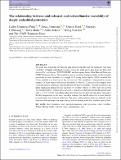The relationship between mid-infrared and sub-millimetre variability of deeply embedded protostars
Abstract
We study the relationship between the mid-infrared (mid-IR) and sub-millimetre (sub-mm) variability of deeply embedded protostars using the multi-epoch data from the Wide-field Infrared Survey Explorer (WISE/NEOWISE) and the ongoing James Clerk Maxwell Telescope (JCMT) Transient Survey. Our search for signs of stochastic (random) and/or secular (roughly monotonic in time) variability in a sample of 59 young stellar objects (YSOs) revealed that 35 are variable in at least one of the two surveys. This variability is dominated by secular changes. Of those objects with secular variability, 14 objects (22 per cent of the sample) show correlated secular variability over mid-IR and sub-mm wavelengths. Variable accretion is the likely mechanism responsible for this type of variability. Fluxes of YSOs that vary in both wavelengths follow a relation of log10F4.6(t) = ηlog10F850(t) between the mid-IR and sub-mm, with η = 5.53 ± 0.29. This relationship arises from the fact that sub-mm fluxes respond to the dust temperature in the larger envelope whereas the mid-IR emissivity is more directly proportional to the accretion luminosity. The exact scaling relation, however, depends on the structure of the envelope, the importance of viscous heating in the disc, and dust opacity laws.
Citation
Contreras Peña , C , Johnstone , D , Baek , G , Herczeg , G J , Mairs , S , Scholz , A , Lee , J-E & The JCMT Transient Team 2020 , ' The relationship between mid-infrared and sub-millimetre variability of deeply embedded protostars ' , Monthly Notices of the Royal Astronomical Society , vol. 495 , no. 4 , pp. 3614–3635 . https://doi.org/10.1093/mnras/staa1254
Publication
Monthly Notices of the Royal Astronomical Society
Status
Peer reviewed
ISSN
0035-8711Type
Journal article
Description
Funding: The contribution of CCP was funded by a Leverhulme Trust Research Project Grant. AS is supported by the STFC grant no. ST/R000824/1. GJH is supported by general grant 11773002 awarded by the National Science Foundation of China. DJ is supported by NRC Canada and by an NSERC Discovery Grant. J-EL and GB are supported by the Basic Science Research Program through the National Research Foundation of Korea (grant no. NRF-2018R1A2B6003423) and the Korea Astronomy and Space Science Institute under the R&D program supervised by the Ministry of Science, ICT and Future Planning. G.B. was also supported by the National Research Foundation of Korea (NRF) grant funded by the Korean Government (NRF-2017H1A2A1043046-Global Ph.D.Fellowship Program).Collections
Items in the St Andrews Research Repository are protected by copyright, with all rights reserved, unless otherwise indicated.

